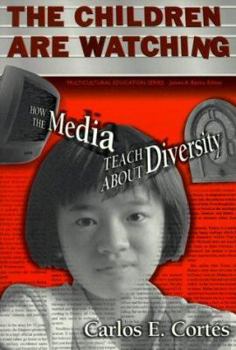The Children Are Watching: How the Media Teach about Diversity
Select Format
Select Condition 
Book Overview
When it comes to teaching about diversity, schools face a powerful competitor - the mass media. Analyzing both entertainment and news media, this important new book grapples with such issues as the ways that media frame diversity-related themes, transmit values concerning diversity, contribute to stereotypes, and influence thinking about topics like race, ethnicity, gender, religion, and sexual orientation. Cort s suggests ways that schools and...
Format:Paperback
Language:English
ISBN:0807739375
ISBN13:9780807739372
Release Date:April 2000
Publisher:Teachers College Press
Length:224 Pages
Weight:0.70 lbs.
Dimensions:0.7" x 6.2" x 9.0"
Customer Reviews
4 ratings
Understanding Media
Published by Thriftbooks.com User , 15 years ago
Cortes holds that media is an educational force that imprints, reinforces, and perpetuates social constructs. In his words, they "contribute to the construction of beliefs and attitudes about diversity" (p. 23). He provides suggestions and frameworks for educators to enhance media literacy, such as conducting a self-assessment of one's own exposure and reactions to media, evaluating what students have already been taught by the media about cultural groups, incorporating mass media as a curricular resource, encouraging analytical thinking, working with parents, and working with the media. He discusses a point of concern that I share: studies of media treatment are frequently unigroup and do not compare treatment across groups. He states, "while a unigroup analysis can suggest such treatment patterns, only a comparative analysis can confirm it" (p. 54). More comparative analyses leading to cross-group dialogue are certainly needed to gain diverse perspectives. This text is an excellent resource for multicultural education.
Interesting read
Published by Thriftbooks.com User , 15 years ago
I read this book in context of a college course, and I found that Cortes makes a clear statement about how media can affect our perceptions on race, culture, gender, etc. Cortes was good at keeping his personal beliefs out of the book, while still using personal stories about his grandchildren to make examples. This was a clear, concise, easy read.
experience counts
Published by Thriftbooks.com User , 20 years ago
During the fall of 2001 I had the privilege of interviewing Dr. Cortes by telephone about his 30 years of experience in working with the issue of diversity. This book is a reflection of Dr. Cortes' commitment to proactive approaches to the inevitable conflict that results between groups that see/perceive the world differently.He is an uncommon voice in the all-too-common world of media. His assessment is that diversity is 'informally' taught through popular media in an uncoordinated manner to the detriment of our children is accurate.His advocacy is hardly limited to his own ethnic background, and his insistence that there must be limits to tolerance is refreshing in current times of political correctness.This book should be read by educators, parents and media professionals.
Very lucid and revealing...
Published by Thriftbooks.com User , 23 years ago
Even though as a media literacy teacher of African descent I disagree with some of the conclusions Carlos Cortes makes in his book, I appreciate that he has written it. In a very lucid writing style, especially for an academic, Cortes demonstrates how multicultural issues do indeed exist in mainstream media. He provides in one chapter his example of a media journal he kept in which he records and comments on the multicultural content found in his day-by-day (for a month in this case) encounters with mostly mainstream media. He reads stories about immigration and naturalization, Dr. Laura Schlesinger's observance of Rosh Hashannah, a Latino columnist discussing "the importance of multiethnic role models," the Promise Keepers, Louis Farrahkhan and his call for a national day of atonement, the antibilingual initiative in California, the Million Woman March, Sports Illustrated stories on racism, etc. This is a useful strategy for helping students make conscious use of the media. So often students are led to believe there's nothing there except crime and politics. Basically, Cortes contends that diversity issues are raised in the media. That media is a source of non-school multicultural learning. But what is needed is an analysis of how young people respond to such media content. He shares some of his grand daughter's responses to movies like The Lion King and Pocahontas. Despite the valid criticism these media presentations received, he sees them as occassions for multicultural awareness. For him, the media and the public school system play similiar roles in providing multicultural education, but they each do it slightly different ways.He also argues that students need to be taught how to examine media texts in a critical way--not in terms of bashing media, but in making a critical analysis of its presentations. This means that teachers need to bring media into the classroom and not allow it to be the main teacher of diversity issues. For in many ways, he argues, students learn more about diversity issues from the media and society than they do from the classroom.While I think it's important that he brings this somewhat positive view of mainstream media, I think he should have provided an analysis of what ethnically focused and genered-focused media are doing. In publications like Ms.Magazine, Emerge, Hispanic, ColorLines, and the new Asian American magazines diversity issues and representations are very much present and often provide a very different analysis than mainstream media.Lastly, I was disappointed that he didn't address the role of corporate media and mergers and how it marginalizes and makes difficult for a true diversity of voices to get heard. While yes diversity issues are addressed, they are often presented in sterotypical ways or from very limited viewpoints. While mainstream media, for example, has covered issues on immigration or bilinqual education, it is usually from a White mainstream poin





